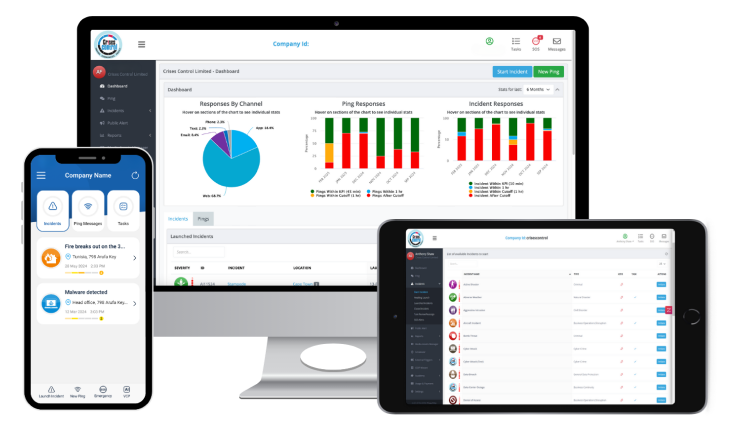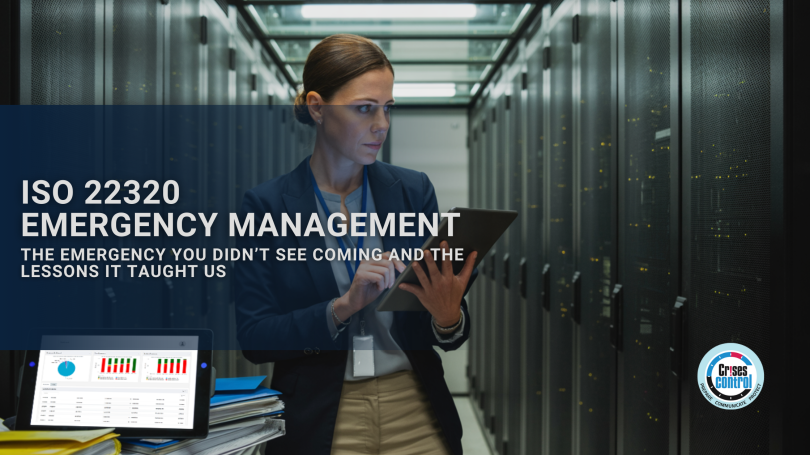Written by Anneri Fourie | Crises Control Executive
Introduction: When Poor Crisis Response Does More Damage Than the Crisis Itself
When disaster strikes, most organisations focus on the immediate threat. Flooded buildings, broken supply chains, or hacked systems grab the headlines. But very often, the real damage comes not from the incident itself but from how poorly the response is managed.
Think back to major weather events, cyberattacks, or the global supply chain disruption in 2021. The companies that struggled the most were often those that lacked clear roles, reliable communication, or a coordinated plan. Staff were left in the dark, decisions took too long, and misinformation spread faster than facts.
This is exactly the problem that ISO 22320 Emergency Management was created to solve. The standard gives organisations a clear structure for incident response so that even in chaotic situations, decisions are made quickly, communication is reliable, and responsibilities are clear.
In this article, we’ll look at why ISO 22320 matters, what lessons we can take from real emergencies, and how technology like Crisis Management Software, Mass Notification Software and Incident Management Software helps bring these principles to life.
Why ISO 22320 Emergency Management Matters
ISO 22320 is an international standard for emergency management. It sets out how organisations should prepare for and respond to incidents in a structured way.
At its core, the standard focuses on three areas:
- Incident response structure. Everyone needs to know their role and authority during a crisis.
- Information management. Communication must be accurate, consistent, and reach people in time to act.
- Coordination and cooperation. Different teams, departments, and external agencies must work together seamlessly.
Without these foundations, responses quickly become fragmented. People duplicate work, critical messages are delayed, and leaders make decisions based on incomplete information. The result is confusion that magnifies the damage of the original incident.
By following ISO 22320, organisations create incident workflows that are predictable and reliable under pressure. The standard is also audit-ready, giving regulators and partners confidence that emergency management is not left to chance.
Lessons from Real-World Emergencies
1. Weather Disasters: Communication Gaps Cost Time and Safety
When Hurricane Sandy hit the United States in 2012, many businesses were caught off guard by the communication challenges that followed. Staff and customers needed updates immediately, yet many organisations relied on outdated phone trees or single-channel communication methods. The result was delays, uncertainty, and in some cases, avoidable safety risks.
Lesson learned: Multi-channel communication is vital. A modern Mass Notification Software sends alerts through SMS, mobile apps, voice calls, and email at the same time. This ensures critical updates reach people wherever they are. ISO 22320 highlights the importance of reliable information management, and multi-channel alerts directly support that requirement.
2. Supply Chain Disruption: Fragmented Responses Increase Losses
The supply chain crisis of 2021 exposed weaknesses across industries. Manufacturers and retailers alike faced shipment delays, rising costs, and stock shortages. But the most damaging impact often came from the lack of coordination between different stakeholders. Without structured workflows, organisations struggled to respond consistently and keep suppliers, partners, and customers updated.
Lesson learned: Fragmented response equals prolonged disruption. Incident Management Software provides structured workflows that align with ISO 22320, helping teams assign tasks, monitor progress, and maintain visibility across the entire chain. This is a clear example of how structured incident response saves businesses, not only by reducing downtime but by protecting customer confidence.
3. Cyber Incidents: Every Minute Matters
When a cyberattack occurs, the speed of response can determine whether an organisation recovers quickly or suffers lasting damage. Many companies still rely on siloed systems or manual processes, which slow down the flow of information and prevent leaders from making informed decisions.
Lesson learned: Real-time situational awareness is critical. ISO 22320 emphasises fast decision-making supported by reliable information. Deploying emergency management software for ISO 22320 allows security and IT teams to communicate instantly, collaborate securely, and log every action taken. This not only strengthens response but also provides the audit trail needed to meet compliance requirements.
What ISO 22320 Requires in Practice
ISO 22320 is not just theory. It sets out practical requirements that organisations must be able to demonstrate. These include:
- A clearly defined command and control structure with assigned responsibilities.
- Documented communication processes that ensure consistent information across teams.
- The ability to work with external agencies such as emergency services or regulators.
- Processes to capture and share information in real time.
- Regular testing and exercising of plans to prove readiness.
These requirements cannot be met with paper-based plans alone. Modern emergencies evolve too quickly, and the expectation from regulators, customers, and the public is for immediate, coordinated action. This is where digital solutions play an essential role.
For organisations also working towards ISO 22301 compliance, see our guide on ISO 22301 compliance software.
The Role of Technology in ISO 22320 Compliance
Technology bridges the gap between planning and execution. It makes ISO 22320 practical rather than theoretical.
Crisis Management Software: Structure and Accountability
A crisis rarely unfolds according to plan. Having a digital platform that sets out workflows, responsibilities, and communication channels means teams can act without hesitation. Leaders see the full picture, decisions are logged, and accountability is clear.
Mass Notification Software: Fast, Reliable Communication
Mass notifications ensure no one is left uninformed. In compliance terms, the best mass notification software for compliance allows organisations to demonstrate that every stakeholder can be reached, whether they are employees, suppliers, or the public.
Incident Management Software: Evidence and Audit Trails
Incident management tools automate task assignment, record every step taken, and generate reports that prove compliance. This evidence is essential when demonstrating ISO 22320 compliance during audits or reviews.
Together, these tools give organisations the means to deliver a structured, reliable response every time.
How Structured Incident Response Saves Businesses
A structured response is not just about passing audits. It has real, measurable benefits:
- Reduced downtime. Clear workflows mean faster decisions and quicker recovery.
- Regulatory assurance. Logs and reports simplify compliance and reduce the risk of penalties.
- Trust and confidence. Employees, customers, and partners are reassured when an organisation communicates effectively during a crisis.
- Long-term resilience. Lessons from each incident feed into improved planning and response, strengthening the organisation for the future.
Organisations that treat incident response as a core business function, rather than an afterthought, consistently perform better during disruption.
How Crises Control Supports ISO 22320 Compliance
Crises Control provides the tools organisations need to align with ISO 22320 and turn compliance into action. Our platform delivers:
- Crisis Management Software that ensures incident response is structured and coordinated.
- Mass Notification Software that reaches people instantly across multiple channels.
- Incident Management Software that automates workflows and captures audit-ready evidence.
- Compliance support that helps organisations maintain readiness and demonstrate alignment with international standards.
This combination means organisations in sectors as varied as finance, healthcare, manufacturing, and government can be confident in their ability to respond quickly and effectively when emergencies occur.
Conclusion: Be Ready for the Emergency You Didn’t See Coming
Emergencies are inevitable. What makes the difference is how prepared your organisation is to respond. ISO 22320 gives a clear framework for emergency management, but without the right tools it remains a document rather than a living process.
With Crises Control, you can move from static plans to real-time, coordinated response systems that protect your people, your operations, and your reputation.
Contact us today to request a free demo and see how Crises Control can support your journey to ISO 22320 compliance and beyond.
Request a FREE Demo

